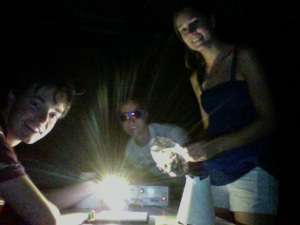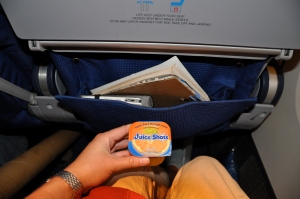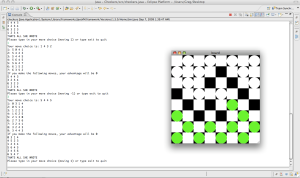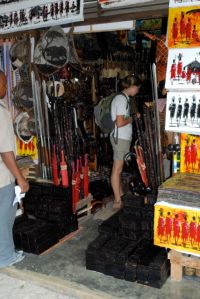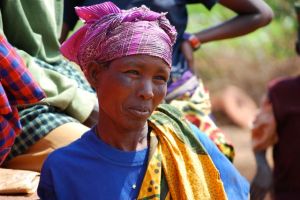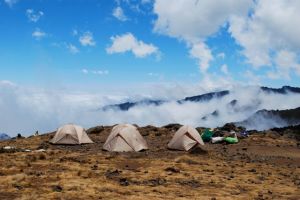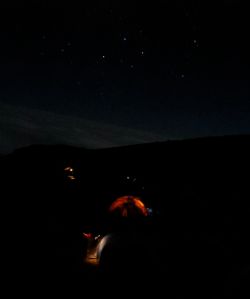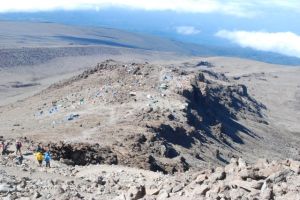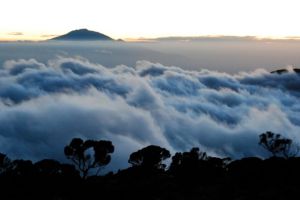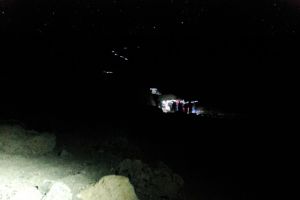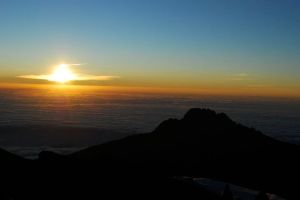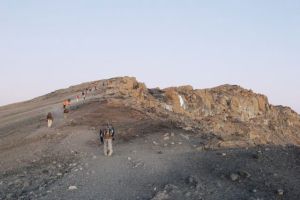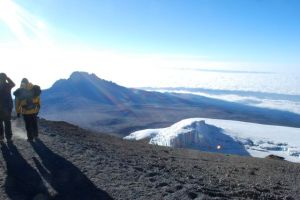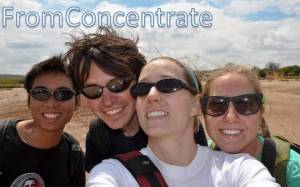FromConcentrate Website, up and running!
Our website is up and running! Check it out: www.fromconcentrate.org!
Very preliminary stages, but keep checking back as it develops. And watch the video for a great overview of what we were up to this summer!
Prototyping back on campus!
While Greg has been busy in Africa conducting more research for our project, Bryan, Lesley, and I have been working together back on campus at the Design School and Terman Loft.
The three of us are interested in prototyping a light fixture that provides disperse light for long enough each night to provide a household enough light to increase their mobility within the home, study, read, and cook by.
We ordered some LEDs online and put together the circuity work for them.
We also have been playing around with different mirror surfaces to learn study their capacity to provide disperse light.
A FromConcentrate sign!
I meant to post this a while ago, but this is a fun little story about our flight back from Tanzania to the states. On the Dar es Salaam to Amsterdam leg, a sign of a successful needfinding trip completed and a successful project future appeared in a message on my little airplane refreshment… look closely! 🙂 See it?
Kenya
I’m writing from Kisumu, Kenya right now. I don’t have much time here at the Internet cafe, but I wanted to share a couple of first impressions that surprised me. I will try to upload pictures later when I get a chance.
1. Compared to Tanzania, Kenya is really developed. It feels and looks like the West in comparison, although I know I’m going to go back to the States and find that my scale of development has been a little skewed. Anyway, even in cities like Nakuru and Kisumu, most of the roads are paved, the business centers look nice, well built, and clean, and there is a broader range of available products, especially American and European products.
2. Kenya feels a bit like India. The streets, especially in poorer areas, are extremely crowded, and dirty. It is very reminiscent of Delhi, although there are not quite so many people.
3. Kenya is safe. I don’t know why it still remains on the US Travel Warning list, but I have not felt unsafe once since I got here, and all of the expats/long term travelers I have met here have said the same. However, the places up North, near Somalia, may be more dangerous.
4. Everyone seems to speak Swahili and English. I had heard that not everyone speaks Swahili, but that is mainly what I hear on the street, with a smattering of English. It is more difficult to understand here than in Tanzania, and I’m more inclined now to believe Tanzanians when they scoff at Kenyan Swahili. Interestingly, newcasts are in English, but often the interviews and video clips in the stories are in Swahili with no translation.
Tanzania’s Games
Besides soccer, the two most common games are pool and “drafti” (checkers). I have seen other games, all homemade, but these are the ones that appear most often. Pool is played out on the street, usually with a homemade awning to protect the table. Checkers is played wherever people feel like.
The checkers boards are painted or drawn, with bottle caps for pieces. One side has the caps face up, and the other side has them face down. People take the game very seriously, and betting is not uncommon. I sat down for a couple of games against some good players (without betting), and got soundly beaten. Now, for those of you who don’t know, I play chess pretty regularly, and have always considered checkers to be that game of my childhood that I could never lose at. So, losing was a bit of a shock. Granted, they play slightly different rules here than I’m used to (forced take, kings can move any distance along a diagonal), which does change the strategy a bit. They don’t really take time to think, it’s usually less than 10 seconds per move, so I feel bad thinking a position through. You need to look a considerable number of moves ahead to beat a good player, and they, who grew up with the game, have a distinct leg up on me in the faster games. Anyway, it appears that the strategy here is deeper than I had thought. It saddens me to think that a lot of these players (I’ve played on the street and with the Kili porters) did not have the chance to go to secondary school. Their skill at drafti says something about their wasted intellectual potential.
Anyway, I’ve been a little bored here in Karatu waiting for market day, so I decided to build myself a checkers solver. It plays the game of checkers, and tells you the best move in any position. After Kili, I needed a nerdy moment. I programmed the solver in Java, and it analyzes a particular position with a recursive algorithm, looking a certain number of moves ahead (you can specify how many). Here’s a screen shot, along with the cryptic move outputs that tell you what the possible moves are and what the best move is. It seems to work, but I haven’t had time to sit down and actually learn from it.
I’ve only played pool once here, but it was quite an experience. They keep the felt immaculate (I really have no idea how, since they play outdoors in all this dust). The table and balls were small, and the cue was smaller. The cue also looked more like a golf ball, it had so many dents and pockmarks. Needless to say, it was difficult to hit the balls straight. The games seem to just go on and on, until someone manages to hit just the right dent in the cue to sink the 8 ball. Anyway, people (men) gather around pool tables in the evening that are set up under small shelters.
Interestingly, these games seem to be only for locals, as the craft shops sell mancala and chess sets, but no checkers sets or pool equipment. I thought before I came that mancala was the African game, but that was clearly just my ignorance. I’ve seen a grand total of one game of mancala in my time here, and no games of chess.
A few notes on language
As you all know, I’ve been trying to learn Swahili for the last eight weeks. This is especially relevant as I set off for my trek around East Africa. It is going slowly, mostly because I started from zero, and haven’t had time to memorize sufficient vocab. I’m confident that I will at least be able to get around during my travels: order in restaurants, get directions, ask a few basic questions, answer their basic questions, etc, of course with the help of my trusty Swahili Phrasebook. This book has been great, except for a couple, rather glaring, holes, which seem to indicate that the book was written in English for another Romance language, and then translated to Swahili. As such, I think it highlights some key differences in Tanzanian culture.
First, greetings. People have said that language indicates what is important to people by the number of words that that language has for a concept. In Swahili, that concept is “hello.” The phrasebook lists one greetings sequence – “hujambo” followed by “sijambo,” but I’ve found that this is rarely used. My sense is that it is equivalent to a formal “hello, how do you do,” rather than an everyday greeting. I feel like I come across new greetings every week, but some of the commonly used ones are: “mambo,” (response: “poa,” cool), “vipi” (response: “safi”, clean), shikamoo (greeting for a respected elder), “habari” (response, “nzuri”), “habari za …” (can be filled in with a seemingly endless set of words, at least dozen, to denote good day, good evening, good afternoon, etc), “shwari”, “jambo”, “sema komanda,” etc. Many of the responses can be mixed and matched, and there are a bevy of other responses, most of which I can’t remember in time to use. So I stick to “safi,” “poa,” and “jambo,” and hope I don’t offend anyone. Also, when someone says “shikamoo” to me, which happens more than you might think (I guess I’m getting old), the correct response is “marahaba,” which can be shortened to “maraha.” Tanzanians take their greetings very seriously, and a single greeting sequence might involve three or more of the above phrases.
I want to talk more about “sema komanda” because I love this phrase. William taught it to me on Kili, and apparently it’s Tanzanian street lingo. It translates roughly to “What’s the word, Commander!” at which point you launch into normal greetings. From what I gather its like “Yo, what up, dawg” in English. There are also a number of other military inspired greetings like “meja, meja,” (Major, Major) and I forget the others.
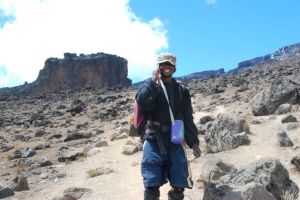
Sema Komanda! Guides and porters often used this greeting on the trail. Here's WIlliam greeting someone on the phone.
Second, “hamna shida.” This phrase did actually make it into the book but it’s buried in the middle somewhere. It needs to be on the front cover in BOLD. The song “hakuna matata” (Kenyan Swahili) from the lion king should really be “hamna shida.” And, as strange as that song’s subject matter sounds to us, it sums up the laid back Tanzanian attitude towards life more than any other two words can. We’ve talked about this before, so I’ll stop here.
Third, “please.” The word is “tafadhali,” but I don’t think I’ve heard a single Tanzanian use it in eight weeks. They use “asante” (thank you) a fair amount, and “karibu” (welcome, as to a house, or you’re welcome, after you say “thank you”) all the time. However, “please” just doesn’t make it into their vocabulary. I’m not entirely sure why, but Tanzanians are extremely nice in general and I think it may be assumed that a request is polite or not meant to impose, without the need for an explicit indicator of politeness.
I asked Japhet, one of the CPAR staff about this, and he said that yes, it is often assumed that you are polite. Tanzanians are seen as very polite in general by other East Africans. Apparently, people use “naomba,” which I haven’t found in the phrasebook, meaning something along the lines of “I’m begging you,” and it is actually considered to be more polite than “tafadhali.” Japhet also said that people with a lot of contact with wazungu have started to use tafadhali more often.
Fourth, prefixes. This has probably been the hardest part of the language for me to grasp. In English, we attach the main meaning of a word to the beginning, which does not change, and details go at the end (for instance, “I have a hammer, I am hammering, The nail was hammered, etc). However, in Swahili, the verb conjugation, tense markers, direct and indirect objects and plural or singular indicator syllables all go at the beginning of a word. For instance, “mzungu” is one white person, and “wazungu” is more than one, and “ninapenda” means “I like” while “utapenda” means “you will like.” To add to the confusion, sometimes the endings of verbs change too: “nataka” means “I want,” while “sitaki” means “I don’t want.” Anyway, it took six weeks for my brain to start attaching meaning to the back of words, and I still sometimes have trouble parsing the beginnings to appreciate the full meaning. I often find myself going back over my memory of what someone just said to figure out the meaning, and having flashes of revelation days later.
Fifth, “yes” and “no.” The word for yes is “ndiyo” (n-dee-yo) and the word for no is “hapana” (ha-pa-na). I was wondering before I came how this worked, because how can you use three syllable words for yes and no? Every other language that I know has one-syllable affirmatives and negatives. Well, the secret is, they don’t actually use these two words that often, definitely not as often as we use yes and no. In fact, “ndiyo” is probably more like “correct” or “affirmative.” For everyday speech, people use “ey” or just nod, or do something else that I haven’t picked up on. I’m not entirely sure what they do for “no,” but sometimes people use “sina” (I don’t have) or shake their heads.
Sixth, eye contact. Eye contact is not as important in Tanzania as it is in the US. While it is still used to initiate conversations and such, often people will have entire conversations with their backs turned. Or, two people will greet each other as they are passing (and not looking at each other) and continue the conversation as they are walking away from each other. As long as the two parties can hear each other, no one seems to mind that they’re talking into empty space.
The Campsites
We camped at a different place each night in different environments on the mountain, and each campsite was interesting and beautiful. The first night was Machame (3000m), in the cloud forest. It was wet and chilly, but the foliage was gorgeous with moss hanging off the trees covered in dew, and flowers everywhere.
The second night, Shira Plateau(3800m), was just above the clouds. Shira camp is right on the edge of the plateau, so the clouds blowing up the mountain roll off the ridge and dissipate 100 feet from our campsite. The effect is stunning. The rugged mountain terrain partially bathed in clouds in an every changing painting of rock and cloud, and the perfect volcano cone of Mt Meru in the background was picture perfect. When the sun started to set, it was magical. I also got in some rock climbing on the protruding boulders, and found a cool set of cairns on top of a ridge. I also went outside early in the morning to check out the stars, and they were incredible as you might imagine. Constellations, planets, shooting stars, the Milky Way, and satellites were all bright and clear in the utter darkness at 12,000 ft.
The third night, Barranco(4000m), is in the middle of a valley at the foot of the summit cone. The imposing Barranco Wall (the next day’s climb) looms over one side, and again, the clouds blew up the valley to dissipate around us. The weather would go from sunny to middle of cloud and back again in the span of a minute. The clouds also formed a cloud rainbow, with the mountain as a backdrop, which unfortunately, didn’t show up on the camera as well as it did in real life. A truly beautiful location.
The fourth night, Barafu(4600m), meaning “ice,” is perched on a ridge, the ridge that you climb to the summit. You can see most of the summit day’s climb from camp, as well as the satellite peak of Mawenzi. This is a high alpine, or arctic environment, and there was not a living thing in sight, other than the crows that feed on the campsite refuse. Speaking of refuse, Barafu camp was really dirty, with trash and food scraps everywhere. The other campsites had been tolerably clean to very clean. But, the views of sunset, and the stars were incredible, and made up for the trash.
The fifth night, Mweka on the descent route, is back in cloud forest, and it’s much the same as Machame. I played drafti (checkers) with some of the porters, and got my butt handed to me. I had never thought of checkers as a difficult game, especially after chess, but I’m certainly missing something major. I’ll post on checkers later.
I’ll leave you with this picture of Meru from Shira camp. It was taken at the very end of sunset in very low light conditions, cool effect. I wish I’d remembered the tripod…
Summit Day

The first pitch from Barafu camp. Looks short right? I thought so too, but this part takes 45 min to 1 hour.
This account was surprisingly hard to write, given how eventful it was. I look back on it now, and realize that altitude reduces your capacity to think and feel. I think it affected my memories as well, they are softer, fuzzier, and simpler than normal. It’s like looking at the mountain from far away, the general shape is clear, and even some of the route is visible, but there’s no detail. In fact, I think the pictures that I took are actually filling in my memory; they are what come to mind first when I try to think of details.
Summit day is long. There’s just no way around that when you have to climb more than 1200m at high altitude. Most people also try to make it up to the top for sunrise, which happens year round at about 6:30am. As such, most groups start hiking from Barafu camp at 11pm or midnight. It’s pretty brutal, especially given that most people get into camp at 4-5pm the evening before after a full day’s hike. William and I decided to leave at 1am, because we knew we’d be going faster than average.
I woke up with a splitting headache. Yeah I know, great start. I did what I could: I popped some Advil and hoped for the best. We started up the mountain, and the stars were incredible. The moon had set, so it was just us and stars. We could also see all of the headlamps of the other hikers bobbing in front of us, and they looked like stars as well. Combined with my altitude delirium, it was really beautiful. Luckily, as we got moving my headache started to fade. It was pretty cold, probably about freezing when we started from camp.
After my Shasta experience when all of my water had frozen solid, I had decided to sleep with one of my water bottles in my sleeping bag to warm it up. This turned out to be a great decision, as I had water all the way up the mountain. The threads kept freezing, but eventually I just left it partially unscrewed.
So there we were, moving fast up a mountain that I could barely see. However, from what I could see, it didn’t look that far to the top. Oh, are looks deceiving, this mountain was just so much bigger than the brain can process. We topped the first ridge, it looked like the top was just over the next ridge. Then we topped the second, and there the summit was, just over the next hump. Then we reached the third ridge, then the fourth. Yeah, you get the point. All of this time, the air was getting thinner, and exhaustion was creeping into my body. Exhaustion of the kind that you can only get above 16,000ft. I’ve been higher than 16,000ft twice now, and I’m convinced that I have NEVER been exhausted below 16,000ft, I have merely been tired. True exhaustion is when it hurts to merely put one foot in front of the other, when you can’t imagine taking another step, when you think it’s impossible move another inch. So, you don’t think. You just do. You clear your head of thoughts, or you think about the stars, your warm tent, the summit, anything but the loose scree underfoot. You focus on your guide’s back, and pretend he’s not actually moving. You forget that you have legs, even a body at all. You simply exist.
William turned out to be somewhat hardcore. He had kept saying to me, that he’s hadn’t had a client who failed to reach the summit since 2004, and that we couldn’t fail. We’d been hiking for about 1.5 hours straight since camp, and I thought it would be a good time to take a short break, get some water, and a bite to eat. So I asked, “tunaweza simama hapa?” (can we stop here). William turns to me, and says, “Gregory, are you SERIOUS? Are you SERIOUS about getting to the top? Because it seems to me that you are not serious.” I got a nice little lecture there on the side of the mountain on my physical fortitude but mental weakness. In retrospect, it’s pretty funny. Then, I was confused and tired, and wondering, what is going on? So, we pressed on. And on. And on. 4 hours after we left camp, he finally turns to me, and says, “from here, I know we can make it, so you can rest.” I gratefully sat down, munched on a sandwich, and grabbed some water.
As you might imagine after hiking up a mountain for 4 straight hours at extreme altitude, I was pretty exhausted at this point, and he told me we had two hours left. “How was I going to make it for another two hours?” I thought. It was bitterly cold, probably somewhere around 15oF, and my body had long since stopped generating heat. Just then, I noticed a little color in the sky, the dawn was breaking. Maybe, just maybe, the summit was within reach. We pressed on, and there was Stella Point, our arrival point on the rim of the crater. We reached it at about 6am, just as the brilliant colors of the dawn broke on the mountain. From Stella Point, I could also finally see the summit on the far side of the crater, far away, but not too far. Hope also dawned on me.
We walked along the crater, slowly, and with frequent breaks. The air was just as thin as I remembered, and the climb up had used up most of my reserves. I was having trouble moving more than about 25 yards at a time. My headache had come back, along with some nausea. I was hallucinating as well, and the glaciers danced in my eyes, like they were alive. It was trippy, and not altogether pleasant. At this point, there were a number of other hikers, some being supported by their guides, and others walking under their own power. That walk around the crater seemed interminable as we walked by 40 foot tall walls of ice, scrambled over rocks, and avoided the precipice down into the crater on our right. But finally, there it was: the sign at the top of Uhuru peak, the roof of Africa. At this point, I couldn’t feel my toes from the cold, and my legs were numb with exhaustion. I wish I’d had the energy to celebrate. All I managed was to think, “this is pretty cool,” and even that was an effort. But we were at the top, the highest point in all of Africa, the top of the world’s highest freestanding mountain on land, the point from which you can see more of the Earth’s surface than any other. A successful day’s work, mission: accomplished.
My Odyssey
I will be traveling alone around East Africa for the next month or so. The goals are:
- Meet with various NGOs and important folk about the project
- See if the needs we saw here in the North of Tanzania are broadly applicable
- Continue to learn about how people live and local culture
- Have an adventure exploring some really cool places!
My intended destinations are Nairobi, Nakuru, Kisumu, Kampala, Jinja, Mwanza, Kigoma, Tabora, Dodoma, Iringa, Mbeya, Mgorogoro, Dar es Salaam, and Tanga, but of course that may change as other interesting things come up. I am trying to stay with locals wherever possible, to get a better sense of the local rhythm and culture, and I will hopefully be doing some more homestays in villages. I will try my best to stay in touch, but internet might be spotty as I venture into the West and South of Tanzania. I have prepared a number of blog posts for the coming weeks on previous topics, so enjoy!
The Need
Reiterating the need for power here, even in electrified Karatu, we had a long power outage today. I was asleep when the power went out last night, but the outage was somewhere between 14-20 hours. I walked around the town while the power was out, and it seems that only the banks, gas stations, and a couple of upscale hotels run backup generators. Oh, and of course, it’s Sunday, so the preacher’s sound system was on a generator as well (you can hear him for miles Friday, Saturday, and Sunday). Everyone else, including CPAR, was in the dark. I ate dinner on the street by candlelight (chipsi mayai), and hung out with a friend in a bar by kerosene lamp. I think that this was the first time I’ve spent a significant amount of time after dark without electricity, because I usually carry my headlamp if I know there’s no power. It really made me appreciate how dark it is at night (the stars were very bright), and also how electrified Karatu is. There are lights on stores all along the main strip, and some on stores and restaurants on the side streets.
I also met a local man, Yasir, who I will post more about later. He lives in a nice house in Karatu, but has no electricity, and it would cost him about 1.5 million Tsh($1,200) to get it. He’s in advanced secondary school, and he has an examination on Oct 5th that he needs light to study for. I told him that I’m working on solar, and thought that I was clear that the device wasn’t quite ready, but apparently I didn’t make that clear. That night he talked to his sister about it, and they were both really excited to buy a system in the 200,000-300,000 Tsh range to run lights in their house. He actually searched all over town the next day to find me to ask how to get one. Needless to say, I felt really bad having to break it to him that he wouldn’t be able to get one for awhile. People like Yasir all over Karatu need our device, and they need it now. It’s up to us to provide them a quality product as soon as possible.
-
Archives
- October 2009 (2)
- September 2009 (10)
- August 2009 (17)
- July 2009 (22)
- June 2009 (7)
-
Categories
-
RSS
Entries RSS
Comments RSS

